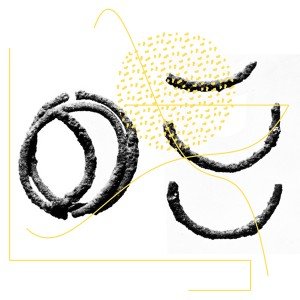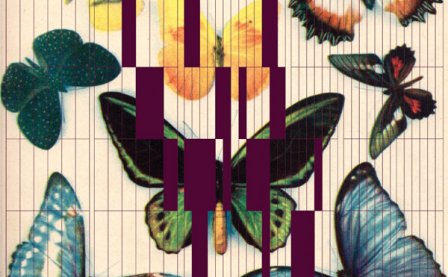The main difference between Jar Moff’s meticulous sound collages and any other non-linear mix is that when the Athens-based musician fashions a patchwork of samples, any trace of the original version is left to thrash and brawl against its new surroundings as opposed to assuming a smooth transition. The trick is that he still manages to make it sound awesome.
This has a lot to do with both the number of cuts that Jar Moff uses — 220 of which are knotted throughout Financial Glam’s 45-minute duration — and the way that each fragment is treated. There is a predetermined trajectory that shapes the direction of the artist’s sample bank, and if he doesn’t like the way it’s panning out, then he’ll bin it — no questions asked; “[if it doesn’t] fit in with the rest of the long piece (thematically, sonically or whatever), I throw the track away, in the garbage.” An immediate example of that contrast can be heard between his debut album for PAN, the brilliant Commercial Mouth, and a mix he did for TMT last year called patisiwn moutra. Where the former casts its samples within the compositional dynamics of the piece, the latter was allowed to mutate in accordance with the samples themselves, which resulted in a ruffling crash of sound with original particles still discernible through the wreckage.
Financial Glam is a continuation of the sonic collage format, and although it doesn’t have the same immediacy as Commercial Mouth, it makes for another stunning example as to how Jar Moff operates and how his samples interact with each other. Up until recently, he was one of the lesser-known artists on Bill Kouligas’ PAN roster. However, since Commercial Mouth was released in December 2012, he has received a great deal of exposure by virtue of the impact his collages have. Despite assuming a confrontational and abrasive aesthetic, his music is rich and full of detail, which makes each repeat listen feel as though you are experiencing these sounds for the first time, over and over again. Financial Glam’s texture is rough and coarse, like some boundless stretch of sandpaper, but if you look closely enough you’ll find that in the place of anonymous, aluminum specks, there are intricately shaped miniature diamonds of acoustic instrumentation, hushed vocals, and subtle percussion sequences.
Although the titles derive from seemingly ironic statements about socio-economic status, the tracks reveal a personal and intimate approach to the organization of sound that is quite unlike any other. Of equal interest is the selection process and the manner in which each cut is stitched together. On Financial Glam, the former is less easy to discern than on patisiwn moutra, but in an interview with The Quietus, Jar Moff said that he “took a lot of influence from contemporary classical pieces by serious masters like Ligeti, Penderecki, Boulez.” It’s difficult to tell if these are outside influences or if they actually encompass some of the samples, or indeed both. Regardless of their role, these reference points are more apparent on the first half of the LP, where “Kresentosiagona” (Κρεσεντο Σιαγονα in Greek, which translates as “Crescendo of the Jaw”) exposes a distinct collision between feverish acoustic instrumentation — saxophone and guitar — with modulator synths and a minimal, echoic drum pattern. The surrounding material comes in the form of layers, which wash metallic flickering, harsh static, sudden pianos, and cluttering cymbals into a constant rumble that heaves and wanes in its aggression as the track plays out. It causes you to feel constantly on edge, unable to fathom where the next bout of discord will emerge from.
The stitching of these samples is by no means linear — part of the album’s allure is that it’s almost impossible to tell where one edit finishes and where another begins. This is most affecting when any acoustic detritus merges with scraps of electronica, creating an atmosphere of tension and uncertainty that’s uncomfortably menacing in its disjointed structure. Where “Kresentosiagona” bares the most impact, the title track is a lot subtler. It fiddles and pokes its way around the cuts running through it, where rapid whispers and high-pitched violin strings tangle within the twisted murk that drives the track forward. It’s broken up from time to time, most notably by the heavy breaths of a sax player battling with his instrument, which gives rise to a terrific depiction of the human hand amidst an instrumental surge that seems to expose nothing short of mechanical accuracy. Indeed, both pieces have been put together with painstaking detail, and although Financial Glam might not exemplify the refined composition of the music that inspired it, the album certainly has the potential to conjure similar emotive responses once you allow it seep in.
More about: Jar Moff




